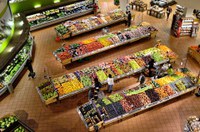Prairie Fare: Enjoy the Season’s Fresh Fruits and Vegetables
(Click an image below to view a high-resolution image that can be downloaded)
I look forward to May because I know that high-quality, rosy red strawberries will be available in my local grocery store. Strawberries are among my favorite fruits.
You may have heard the recommendation about “eating in season.” What does that mean anyway?
Seasonal produce varies by where we live, but we do have the advantage of seasonal produce from other locations reaching our grocery stores.
I do not have a greenhouse in my backyard. If I were to eat what is growing in my garden in early May, I would have nothing to eat. In June, lettuce and radishes make an appearance.
By definition, seasonal produce is at its best quality and, usually, its best price. Many fruits and vegetables come into season in the spring – somewhere in the world.
When farmers markets open, check out the freshly picked produce. The less time that fresh produce spends on the way to your home, the more nutritious it tends to be.
For example, these are some of the items on many seasonal produce guides: asparagus, avocados, bananas, broccoli, cabbage, carrots, celery, kale, kiwifruit, lettuce, onions, peas, pineapple, radishes, rhubarb, spinach, strawberries and turnips.
Watch your grocery flier for sales on fresh produce. Remember that all forms of fruits and vegetables count toward the 1 ½ cups of fruit and 3 cups of vegetables recommended daily for most children and adults.
Unfortunately, many people shortchange themselves on the recommendations for fruits and vegetables. Sometimes, availability of fresh produce can be an issue. We also have noted the increasing prices on a variety of foods at the grocery store.
Here’s the good news: Canned, fresh and frozen fruits and vegetables all count toward your goal.
Push your cart throughout the entire store. All forms of fruits and vegetables are nutritious additions to your diet, and they add variety and color to your plate.
Vegetables are important sources of many nutrients, including potassium, dietary fiber, folate (folic acid), vitamin A, vitamin E and vitamin C. Fruits contain nutrients, such as potassium, dietary fiber, vitamin C and folate (folic acid).
The most recent recommendations from the U.S. Dietary Guidelines for Americans emphasize that we fill half of our plates with fruits and vegetables. Beans, such as navy, garbanzo and kidney, count as either vegetables or protein foods on your plate.
Be sure to rinse all fresh fruits and vegetables under running water prior to using them in recipes. Bagged lettuce that has been “triple rinsed” does not need to be rinsed again. It is ready for your recipes.
Try “sneaking in” some produce in your recipes and your menus with these tips.
- Add shredded carrots to pasta sauce, lasagna or meatloaf.
- Add extra vegetables to casseroles and soups.
- Have a bowl of fruit, such as apples or bananas, on the countertop.
- Serve raw, crunchy vegetables with low-fat dip as a snack.
- Try vegetable kabobs on the grill.
- Have fruit smoothies as a snack.
- Serve fruit for dessert.
Have you taken out your grill? Salmon is rich in heart-healthy fats, and the vegetables provide a variety of vitamins. This tasty recipe features seasonal lettuce and other colorful vegetables. Try having a parfait with fresh strawberries for dessert.
Mixed Greens with Grilled Salmon and Feta Cheese
¼ teaspoon garlic powder
¼ teaspoon ground ginger (if desired)
¼ teaspoon dried parsley flakes
¼ teaspoon pepper
¼ teaspoon salt
4 (6-ounce) salmon fillets, fresh or frozen (thawed)
1 (5-ounce) package spring mix salad greens or fresh romaine lettuce
1 cucumber, chopped
1 tomato, chopped
1 yellow bell pepper, chopped (or ½ red bell pepper and ½ yellow bell pepper)
¼ cup crumbled feta cheese
¼ cup vinaigrette dressing or Italian dressing
In a small bowl, mix the first five ingredients; sprinkle over salmon. Preheat grill or broiler. Place salmon on oiled grill rack, skin side down. Grill, covered, over medium heat or broil 4 inches away from heat until fish just begins to flake easily with a fork, 10 to 12 minutes. Slice salmon into pieces if desired. In a large bowl, toss salad greens with cucumber, tomato, bell pepper and cheese; divide among four plates. Top with salmon; drizzle with dressing.
Makes four servings. Each serving has 525 calories, 22 g (grams) fat, 68 g protein, 11 g carbohydrate, 2 g fiber and 490 milligrams sodium.
(Julie Garden-Robinson, Ph.D., R.D., L.R.D., is a North Dakota State University Extension food and nutrition specialist and professor in the Department of Health, Nutrition and Exercise Sciences. Follow her on Twitter @jgardenrobinson)
NDSU Agriculture Communication – May 11, 2023
Source: Julie Garden-Robinson, 701-231-7187, julie.garden-robinson@ndsu.edu
Editor: Elizabeth Cronin, 701-231-7881, elizabeth.cronin@ndsu.edu




